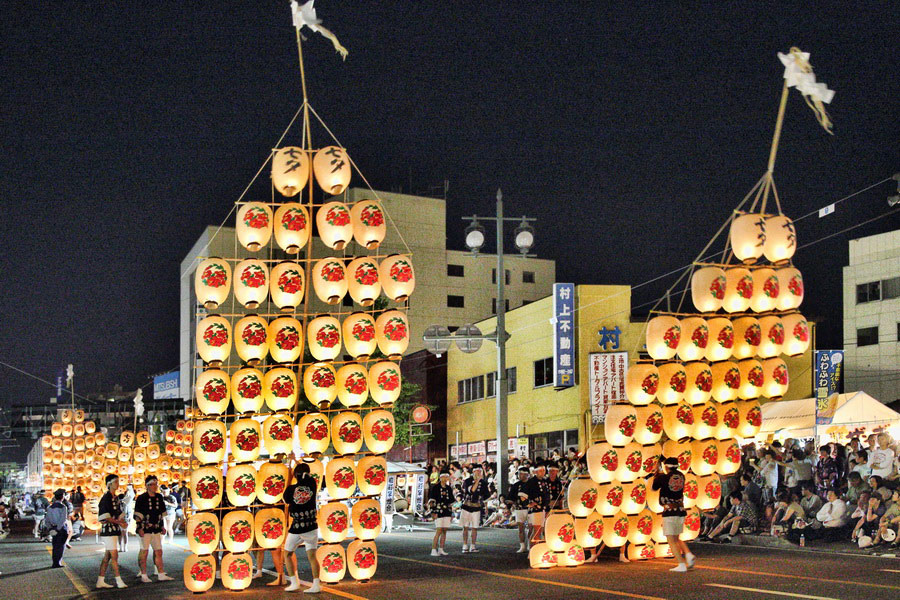Akita Kanto Matsuri

Akita Kanto Matsuri (秋田竿燈まつり) is a Japanese festival held annually in the city of Akita from August 3 to 6. It is one of the three great festivals of the Tōhoku region, alongside Nebuta Matsuri (ねぶた祭) in Aomori and Tanabata Matsuri (七夕祭り) in Sendai. The festival is renowned for its kanto (bamboo poles) balancing performances, where skilled participants demonstrate impressive balancing techniques using lantern-adorned bamboo poles, supporting them on their palms, forehead, hips, and shoulders.
The festival traces its origins to the Hōreki period (1751–1764) as part of Neburi Nagashi, a ritual aimed at cleansing oneself of bad spirits and illness during the summer and ensuring a bountiful harvest. The earliest written account of this tradition appears in Soan Tsumura’s travel diary, "The Road on Which It Snows".
During Neburi Nagashi, participants wrote wishes on paper and tied them to bamboo branches, which they carried through the streets in processions. Over time, candles and lanterns were added to the branches, forming the foundation of the kanto tradition. The paper lanterns used in the festival are designed to resemble traditional reed bags (komedawara) used for rice storage, symbolizing prosperity and hopes for an abundant grain harvest.
During the Meiji era (1868–1912), the festival evolved into its modern form: kanto poles grew larger, and more lanterns were added. The first official Akita Kanto Festival took place in 1881 to entertain Emperor Meiji (Mutsuhito) during his visit to Akita.
In 1905, the festival faced a decline in popularity, with the number of kanto poles reduced from 50 to just 4 or 5, and visitor numbers dropping significantly. This was due to the festival’s shift to the solar calendar, which placed it in July, during the height of the rainy season. However, two key events helped revive the festival: Emperor Taishō’s visit in 1908 and the advertisement of soft drinks on lanterns in 1909, which attracted public interest. Eventually, the festival returned to its traditional lunar calendar dates, significantly boosting attendance. Following this revival, in 1931, the Society of Kanto Masters was established, and in 1966, a dedicated festival committee was formed to oversee its organization.
The highlight of the Akita Kanto Festival is the parade of kanto poles adorned with rice-paper lanterns, attracting thousands of spectators. The kanto poles are classified into four categories based on their size and weight:
- Ōwakamatsu (Large Kanto): ~12 meters tall, 50 kilograms, 46 lanterns;
- Chūwakamatsu (Medium Kanto): ~9 meters tall, 30 kilograms, 24 lanterns;
- Kowakamatsu (Small Kanto): ~7 meters tall, 15 kilograms, 24 lanterns;
- Yōwakamatsu (Young Kanto): ~5 meters tall, 5 kilograms, 12 lanterns.
Each kanto consists of three main parts:
- Oyadake (main bamboo pole);
- Yokodake (horizontal branches holding the lanterns);
- Tsugidake (bamboo extensions to increase height).
To stabilize the kanto poles while balancing them, hari ito threads are used to prevent excessive swaying. The bamboo used for the poles is carefully selected to ensure proper weight distribution, as improper sizing can hinder the ability of performers to execute balancing techniques.
There are five main balancing techniques (meogi) performed at the festival:
- Hirate (平手): Balancing on the flat palm;
- Koshi (腰): Balancing on the hip;
- Kata (肩): Balancing on the shoulder;
- Hitai (額): Balancing on the forehead;
- Nagashi (流し): The act of adding bamboo extensions to increase the height of the kanto during performances.
The main performance takes place after sunset, around 18:50, when over 270 kanto poles illuminate Kanto Odori Street, accompanied by the majestic sounds of taiko drums and flutes.
Although the evening parade is the main attraction, there are also daytime events near Kanto Odori Street. In the plaza outside the Akita Museum of Art, visitors can watch a kanto competition, where both individual and group performers showcase their balancing skills. Entry is free for participants.
For those interested in the history and traditions of the festival, the Akita City Folk Performing Arts Heritage Center offers visitors a chance to see real kanto poles up close and practice balancing a miniature version.
- Opening Hours: 09:30 – 16:30
- Closed: December 29 – January 3
- Entrance Fee: 200 yen (subject to change)
Admission to the evening festival performances is free, though reserved seating tickets are available for purchase in advance.

